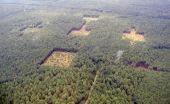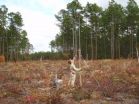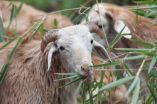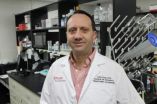(Press-News.org) MADISON, Wis. — Field ecologists go to great lengths to get data: radio collars and automatic video cameras are only two of their creative techniques for documenting the natural world. So when a group of ecologists set out to see how wind moves seeds through isolated patches of habitat carved into a longleaf pine plantation in South Carolina, they twisted colored yarn to create mock seeds that would drift with the wind much like native seeds.
The "seeds" were dusted with fluorescent powder and inserted into custom-made boxes mounted on poles, then released as the scientists monitored local wind conditions.
That night, the field crew returned for a black-light treasure hunt, locating more than 80 percent of the fake seeds, which glowed under the ultraviolet light. The paths of these glowing seeds were matched with output from a computer model to produce the first accurate picture of how wind moves seeds through corridors linking two patches of habitat.
The study, published Feb. 24, 2014 in the Proceedings of the National Academy of Sciences, has echoes of an arts and crafts project, but it has a serious purpose. "Understanding the conservation impact of corridors is at the cutting edge of conservation," says first author Ellen Damschen, an assistant professor of zoology at the University of Wisconsin-Madison.
Corridors are designed to improve conditions for uncommon native species living in separated habitats. Small populations in these "islands" of habitat may be killed by storms or disease. They may lack genetic diversity and be prone to inbreeding. And they may be unable to reach new habitat.
For about 40 years, conservation biologists have discussed building conservation corridors to link isolated patches of protected land. "It makes intuitive sense that these connections could foster genetic and biological diversity," says Damschen, and large projects, including one linking Yellowstone National Park to Canada's Yukon Territory, are taking shape. "Unfortunately, there has been very little scientific evidence for if and how they work."
Most of the studies have concerned animals, she adds, even though plants provide the basic energy and structure to land ecosystems.
Wind matters for the movement of seeds and whole organisms, Damschen says. "In many open habitats, more than one-third of plants are wind dispersed, but there are also insects, spiders, pathogens and fungi that move on the wind."
The experiment, supported by the National Science Foundation and the U.S. Forest Service, began in 2000 with the creation of eight groups of identical patches at the Savannah River Site, a large holding of the Department of Energy in South Carolina. Each set of patches was built at a different orientation to prevailing winds.
The interdisciplinary research group of meteorologists and ecologists found that corridors increased the movement of wind and of their glowing artificial seeds, echoing the results of a computer model developed by Gil Bohrer at The Ohio State University. And when Damschen and fellow scientists in what they call the Corridor Research Group counted newly dispersed plants over the 12-year experiment, they found that a corridor linking two patches of land indeed promotes the diversity of plants dispersed by wind — especially if the corridor is oriented roughly parallel to the prevailing winds.
Both data and the model showed that wind speeds up in certain areas of the patches, and that a strong vertical air movement is present. "Uplift is important because the wind tends to be faster higher above the ground," Damschen says, "and uplift can lead to long-distance dispersal, which is most significant for moving plants around the landscape."
And that is why the study matters for conservation biology, Damschen says. "We predicted that corridors in line with the dominant wind would move more species, and this is what we found. Wind alignment matters for species diversity in conservation areas."
Their results are especially relevant to threatened Midwestern ecosystems like grasslands, prairies and savannas, where big bluestem and milkweed are two of the many important native plants that loft their seeds on the wind.
"In conservation science, it is often assumed that wind-dispersed seeds can go everywhere, but that's not true," Damschen says. "Wind direction, and the shape of the habitat, control where these seeds go. While this adds another factor to consider in management of natural areas, at least the information is on the table so we can make better decisions about how to achieve management goals."
INFORMATION:
Seed dispersal gets a test in carved-out 'habitat corridors'
2014-02-24
ELSE PRESS RELEASES FROM THIS DATE:
Better livestock diets to combat climate change and improve food security
2014-02-24
Livestock production is responsible for 12% of human-related greenhouse gas emissions, primarily coming from land use change and deforestation caused by expansion of agriculture, as well as methane released by the animals themselves, with a lesser amount coming from manure management and feed production.
“There is a lot of discussion about reduction of meat in the diets as a way to reduce emissions,” says IIASA researcher Petr Havlík, who led the study “But our results show that targeting the production side of agriculture is a much more efficient way to reduce greenhouse ...
Marine algae can sense the rainbow
2014-02-24
A new study published in Proceedings of the National Academy of Sciences has shown for the first time that several types of aquatic algae can detect orange, green and blue light.
Land plants have receptors to detect light on the red and far red of the spectrum, which are the common wavelengths in the air. These plants sense the light to move and grow as their environment changes, for example when another plant shades them from the sun. But in the ocean, the water absorbs red wavelengths, instead reflecting colours such as blue and green. As part of the study, a team of ...
A paper diagnostic for cancer
2014-02-24
CAMBRIDGE, MA -- Cancer rates in developing nations have climbed sharply in recent years, and now account for 70 percent of cancer mortality worldwide. Early detection has been proven to improve outcomes, but screening approaches such as mammograms and colonoscopy, used in the developed world, are too costly to be implemented in settings with little medical infrastructure.
To address this gap, MIT engineers have developed a simple, cheap, paper test that could improve diagnosis rates and help people get treated earlier. The diagnostic, which works much like a pregnancy ...
Species conservation poised to benefit from DNA advances
2014-02-24
A biologist at the University of York is part of an international team which has shown that advanced DNA sequencing technologies can be used to accurately measure the levels of inbreeding in wild animal populations.
The research by senior author Dr Kanchon Dasmahapatra, of the Department of Biology at York, and led by Dr Joseph Hoffman, of the Department of Animal Behaviour, Bielefeld University, Germany, may help efforts to conserve rare species.
Laboratory studies show that inbreeding reduces fitness. However, studying the impact of inbreeding in wild populations has ...
Acupuncture holds promise for treating inflammatory disease
2014-02-24
When acupuncture first became popular in the western hemisphere it had its doubters. It still does. But over time, through detailed observation, scientists have produced real evidence that ancient Chinese practitioners of the medical arts were onto something.
Now new research documents a direct connection between the use of acupuncture and physical processes that could alleviate sepsis, a condition that often develops in hospital intensive care units, springs from infection and inflammation, and takes an estimated 250,000 lives in the United States every year.
"Sepsis ...
New study shows a genetic link between feeding behavior and animal dispersal
2014-02-24
New research from the University of Toronto Scarborough shows that animal dispersal is influenced by a gene associated with feeding and food search behaviours.
The study, which was carried out by UTSC Professor Mark Fitzpatrick and PhD student Allan Edelsparre, provides one of the first aimed at gaining a functional understanding of how genes can influence dispersal tendencies in nature.
Using common fruit flies (Drosophila melanogaster), the researchers observed how two different foraging types – known as sitter flies and rover flies – moved over large distances ...
Ecotourism reduces poverty near protected parks, Georgia State University research shows
2014-02-24
ATLANTA--Protected natural areas in Costa Rica reduced poverty by 16 percent in neighboring communities, mainly by encouraging ecotourism, according to new research published today in the Proceedings of the National Academy of Sciences.
Although earlier studies indicated that establishing protected areas in poor regions can lead to reductions in poverty, there was no clear understanding why or how it happens.
"Our goal was to show exactly how environmental protection can reduce poverty in poorer nations rather than exacerbate it, as many people fear," says co-author ...
AGU: Uncovering the secret world of the Plastisphere
2014-02-24
HONOLULU – Scientists are revealing how microbes living on floating pieces of plastic marine debris affect the ocean ecosystem, and the potential harm they pose to invertebrates, humans and other animals. New research being presented here today delves deeper into the largely unexplored world of the "Plastisphere" – an ecological community of microbial organisms living on ocean plastic that was first discovered last year.
When scientists initially studied the Plastisphere, they found that at least 1,000 different types of microbes thrive on these tiny plastic islands, ...
Pinwheel 'living' crystals and the origin of life
2014-02-24
ANN ARBOR—Simply making nanoparticles spin coaxes them to arrange themselves into what University of Michigan researchers call 'living rotating crystals' that could serve as a nanopump. They may also, incidentally, shed light on the origin of life itself.
The researchers refer to the crystals as 'living' because they, in a sense, take on a life of their own from very simple rules.
Sharon Glotzer, the Stuart W. Churchill Collegiate Professor of Chemical Engineering, and her team found that when they spun individual nanoparticles in a simulation—some clockwise and some ...
New study supports body shape index as predictor of mortality
2014-02-24
In 2012, Dr. Nir Krakauer, an assistant professor of civil engineering in CCNY's Grove School of Engineering, and his father, Dr. Jesse Krakauer, MD, developed a new method to quantify the risk specifically associated with abdominal obesity.
A follow-up study, published February 20 by the online journal PLOS ONE, supports their contention that the technique, known as A Body Shape Index (ABSI), is a more effective predictor of mortality than Body Mass Index (BMI), the most common measure used to define obesity.
The team analyzed data for 7,011 adults, 18+, who participated ...




